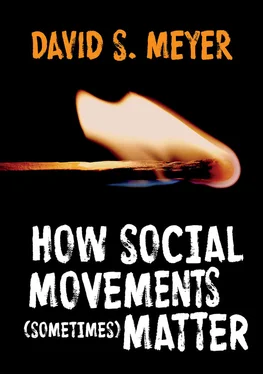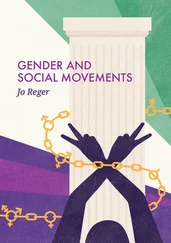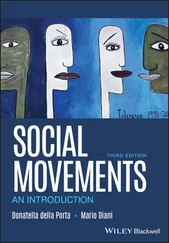The crushing of the Tiananmen protests essentially stifled protest in China for years, and economic liberalization proceeded apace.
But sometimes harsh repression spurs activists to do more. When governments crack down on protest violently, they challenge their own military forces to engage in conduct they may find deplorable. They also expose themselves to international scrutiny and, generally, approbation. The harsh repression of the Iranian government under the Shah served largely to undermine public support for the regime, helped build dissident networks, and essentially encouraged opponents of the regime to organize more effectively. Philippine president Ferdinand Marcos, faced with a domestic insurgency, found that he could not count on the support of his own military. Rather than repress the protesters, the military joined them. Robbed of his support within the military, Marcos was essentially forced to cede power and leave the country with as much wealth as he could carry (Boudreau 2004).
There is, then, a paradox, in which harsh repression can still dissent, or it can stoke it, depending upon the effectiveness of the repression, the solidity of governance, and the resources the opposition has. Similarly, in democratic polities, reform efforts can encourage further mobilization and broader goals, or they can undermine the organization of a protest movement.
The key to unpacking these apparent contradictions lies in the nature of the challenging coalition. When authorities respond to protesters, their prime strategic goal must be to split their challengers. Because movements are comprised of diverse factions with a range of concerns and commitments to different sorts of tactics, government moves provide the chance to reconsider alliances. Government repression challenges those who are less committed or have more to lose to ask whether it makes sense to continue to tie their fate to others less popular. Government concessions, in terms of policy reforms or political inclusion, challenge coalitions in exactly the same way, but with opportunities for change rather than the threat of repression. In both cases, those on the radical edge of a movement and those in its more moderate wing, constantly have the opportunity to rethink how loyal they should be to each other, particularly in the context of potential risks and potential gains. Strong protest is polarizing, pushing bystanders to take sides, and the nature of the schism, particularly how extensive and how large and powerful the forces on each side of the divide are, determines the likely outcome.
Social movements, although ubiquitous, represent commitments and levels of engagement that are, for most participants, unusual. The stalwarts continue mobilizing even when there’s some kind of accommodation with power, but for most people, there is a process of coming to terms with partial solutions, and moving onto other issues or other elements of life (see Hirschman 1982). We can think about that process as institutionalization , that is, setting up a set of relationships with other people, with authorities, and with a cause, that becomes routine, where the costs are limited and predictable (Jepperson 1991).
At peak mobilization, social movements are defined by ongoing engagement with mainstream political life. That moment is always limited, and the outcomes of movements are described by the character of mobilization. One component of institutionalization is entering the political system in some organized way, such as a political party, a stable interest association, or the bureaucracy. Another is marginalization, when those in power are no longer compelled to pay attention to what activists want or what they do. In liberal polities, the decline of social movements is generally defined by both processes. When the margins and the mainstream become more distant from each other, there is a decline in visibility, and the imagination of broad goals and extensive engagement diminishes as well (Meyer 1993).
We can outline a schematic process to map the trajectory of a social movement cycle. We begin with the recognition of a political, social, or policy person. Such recognition could come from government, citizen action, or the confluence of events, like an accident, a war, or new information. The development of a problem may reflect a change in objective conditions, or simply the perception of those conditions. Step two entails the development of a schism among political elites. The divide may come over the recognition of the problem itself, or about the range of possible remedies that can be considered legitimate. The divide within governance leads to a third stage, greater public attention, facilitated by the relevant media of the moment. With divides and political attention, a fourth stage opens when groups concerned with citizen mobilization grow, with new groups developing and established ones taking on new activists, and generating more activity – and visibility. These groups offer criticism of current policies or realities and offer alternatives. Activist groups grow around a particular set of claims and potential resolutions. This is a particularly unstable moment, and liberal democratic governments respond in a variety of ways, often accepting some portion of activist goals or rhetoric while rejecting others. Social movements end with a sixth stage, when a new institutional accommodation is reached, and unusual mobilization no longer takes place (Meyer 1993).
Like any stage framework, this model is a heuristic that offers a map for understanding any movement, but not a very good description of any particular movement. Action is taking place in all the stages at once, and in the contemporary era, movements don’t really end so neatly, but continue on in more modest and less visible ways – although not necessarily with less impact (Meyer and Tarrow 1998).
We need to sum up some of what all this means. Most significantly, social movements are themselves the product of political dynamics, as well as contributors to those dynamics. Social movements surely play a role in creating history, but they are not completely insulated from the history that gives rise to their emergence (Amenta et al. 2010; Giugni 1998). The forces that create the impetus for social protest also create the pressure for political change. In this context, the efficacy of social movements involves maximizing the impact of the waves that they are on, but movements have limited impact on creating those waves.
To make sense of the influence of movements, that is, how movements matter, we need to develop a good understanding of the factors that give rise to them, that is, the conditions that allow movements to emerge in the first place. In this regard, the influence of social movements is a function of the ability of organizers and activists to get the most out of the waves they ride.
Here’s the surfing analogy: Surfing is an extremely difficult sport. A surfer needs to paddle out through current, ducking under or paddling over waves, and then position herself in the ocean ready to catch waves when they come by. As the waves appear in sets, the skillful surfer starts paddling purposefully when a promising wave appears, but there are generally missteps, and there are moments of competition and courtesy with other surfers seeking to ride the same wave. Often, a surfer is wiped out immediately, or unable to catch the wave. The most skillful, however, time their paddling carefully, stand at the right time, and can not only navigate survival upright, but also pose moves up and down the face of the wave. A great surfer can maximize the length of his ride, and pull off when what the wave offers is no longer interesting, paddling out once more to be in position for the next opportunity.
What’s not quite right about this metaphor is that social movements, unlike surfers, can help kick up the waves as well as ride them.
Читать дальше












